‘Starmount’ by C.G.S Hirst 1875. Conservation Assessment and Treatment of an Historically Significant Watercolour
By Amelia O’Donnell - Conservation Technician, State Library of Queensland | 10 September 2020
The State Library of Queensland recently acquired a watercolour painting by Queensland artist Charles Gordon Sebastian Hirst (C.G.S Hirst). Our conservation team have been hard at work conserving this significant artwork. Starmount: the farmstead and property of Mr Charles O’Brien and family at Moggil 15 miles from Brisbane was painted by Hirst in 1875. Hirst was a wandering artist who worked in southeast Queensland in the late 1800s. He earned his keep sketching the homesteads of small landholders who wanted to show their material successes. Importantly, Hirst annotated each of his paintings with the date and location. These details offer us insight into the artist’s travels around the state and a glimpse of the social history of colonialism in southeast Queensland.
Upon arrival at the library, it was clear to see the much-loved treasure had lived a long, hard life. To enable this precious piece of Queensland’s history to be shared with the community it first required some special care and attention. Our skilled conservators undertook conservation treatment on the item to physically and chemically stabilise the artwork ready for exhibition.
In the following paragraphs we’ll detail how this artwork was assessed and describe the conservation treatment it received in preparation for its display at the library.
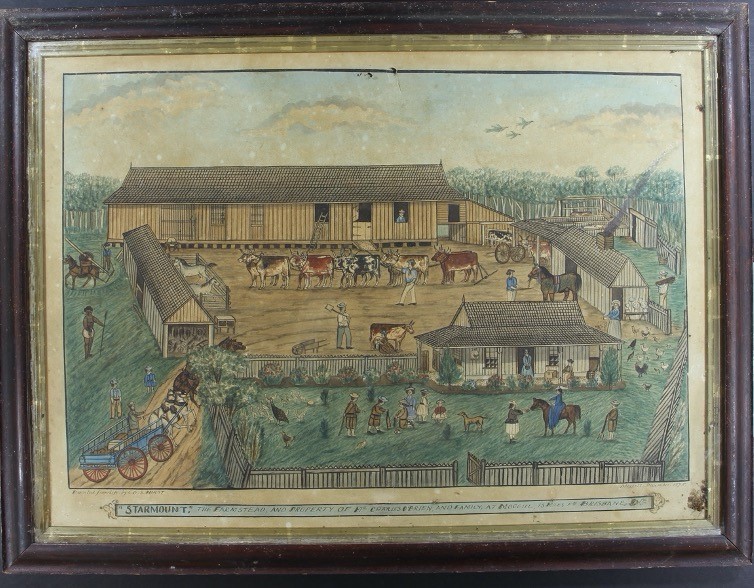
Acc: 32157, Starmount: the farmstead and property of Mr Charles O’Brien and family at Moggil 15 miles from Brisbane. December 1875. Image showing condition of item on arrival to SLQ. Note: discolouration, surface dirt, insect frass and puncture in centre of skyline.
Conservation Treatment Steps:
Assessment
To be able to fully assess the condition of the artwork it was removed from its original frame. This allowed conservators to examine the true extent of the damage and assess the deterioration impacting the artwork
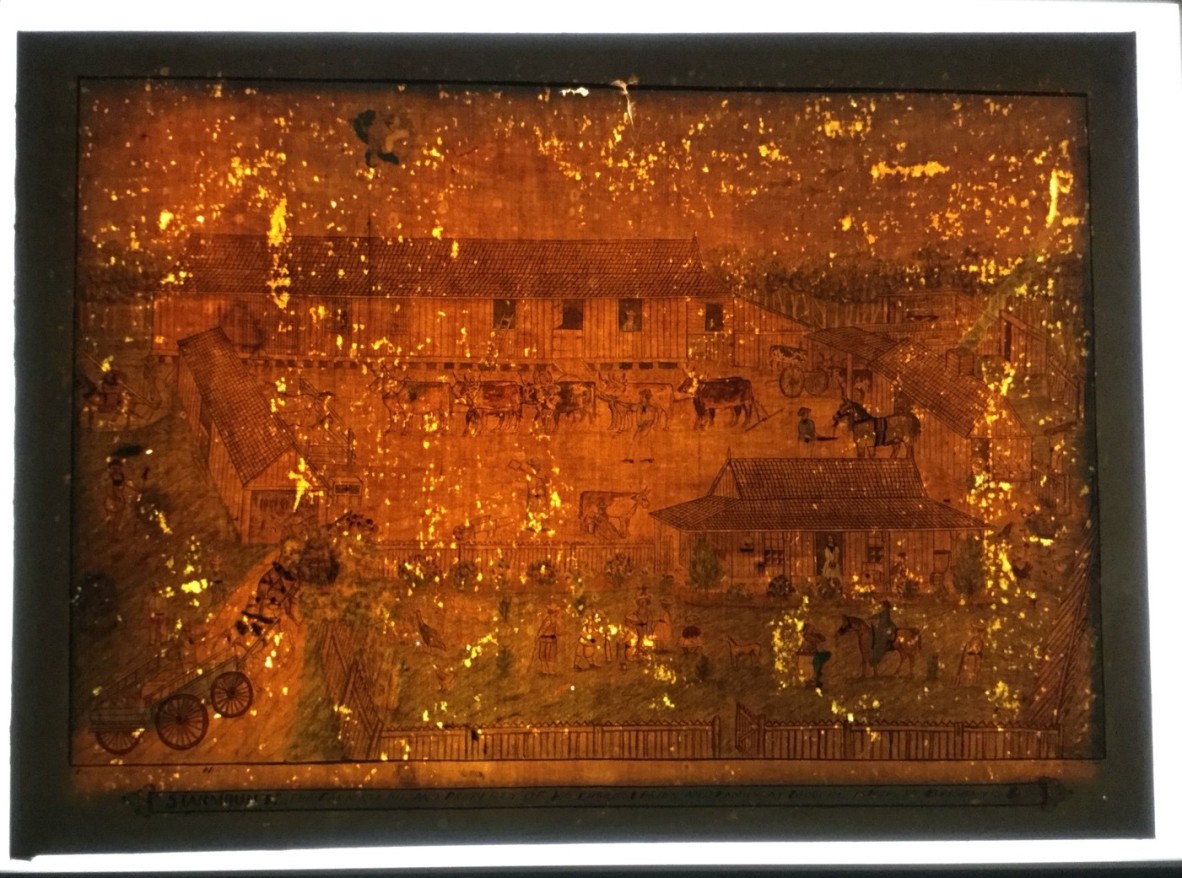
Starmount watercolour painting on linen backing after removal from its original frame. Transmitted light (light shining through from underneath the object) illuminates losses speckled across the surface of the artwork. These spots are where insects have eaten away the paper.
De-framing
Initial examination of the artwork revealed the watercolour on paper was pasted to a piece of linen which was then stretched over a strainer. A strainer is a wooden frame which the artist uses to stretch a linen or canvas keeping it taught. It was decided to separate the artwork from the strainer because wood contains natural acidic compounds that can off-gas and trigger chemical deterioration reactions in paper. Separating the wood from the artwork will help slow the deterioration of the watercolour paper. The wooden strainer forms part of the original item and holds historical significance so it was cleaned and housed separately.
Backing removal
Next, the linen backing was carefully peeled away from the paper substrate which has the artwork on it. The linen was in poor condition with staining, losses, ingrained dirt and insect damage. These signs indicate the linen is unstable and will inevitably cause more damage to the paper if left in contact with it. Like the wooden strainer, the linen backing is considered part of the original item. It was washed in a bath of pH neutral water, dried and flattened under weights then housed separately.
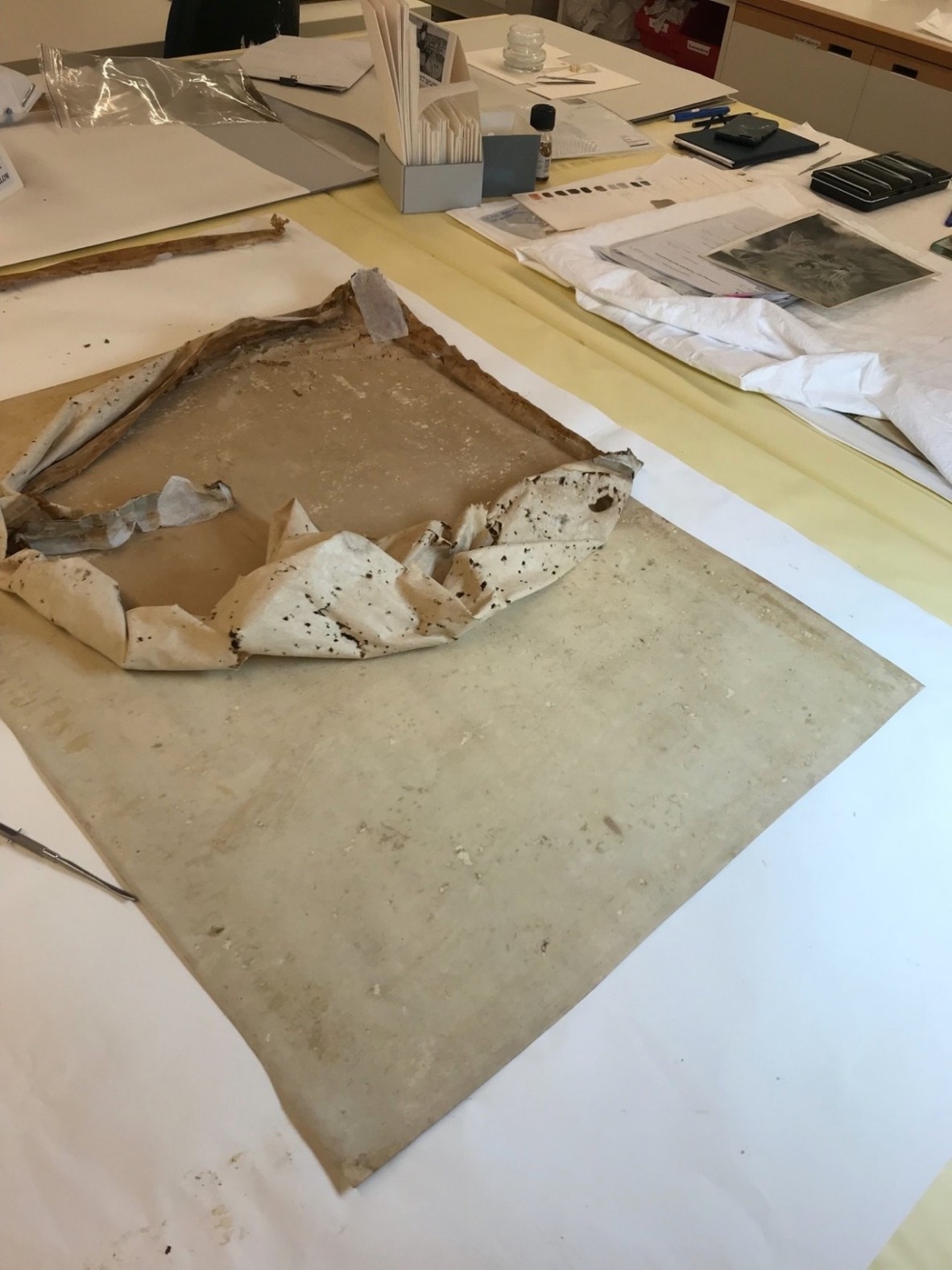
Starmount is sitting face-down on the work bench while the linen backing is carefully peeled back and removed.
Washing
The paper substrate was washed to remove acidic deterioration by- products. If they remain in the paper, they will cause severe physical damage and discolouration. Wait a minute...! Washing a watercolour?! The specialist knowledge and skills of an experienced conservator are required to wash paper safely. We don’t encourage you to try it at home with your own collections, but if you’d like to know more about how to care for your collections please get in contact with us by submitting a conservation query via the State Library of Queensland website.
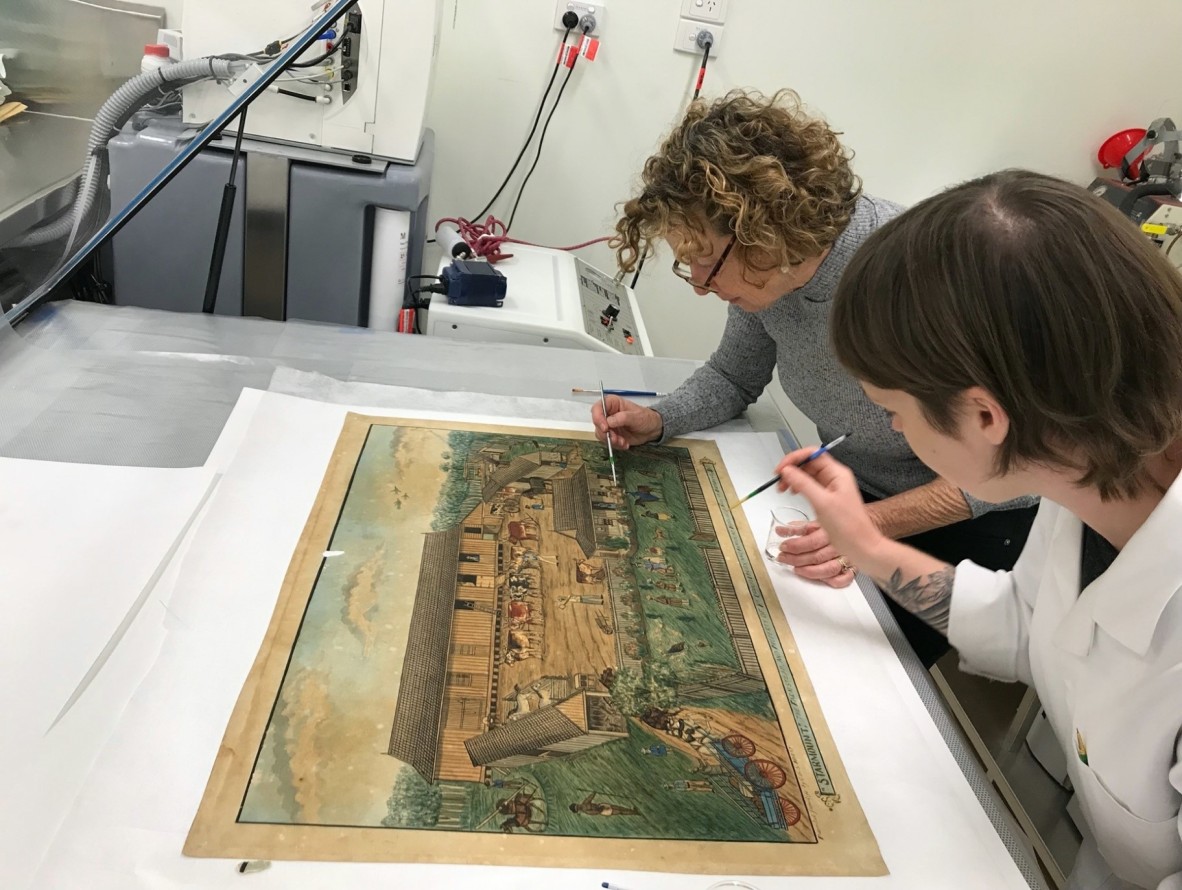
Starmount watercolour painting after removal from wooden strainer and linen. The item is being washed using a suction table and local application of deionised water on heavily stained areas.
Repairs
A small puncture hole in the skyline area was mended using archival repair tissue and cellulose paste. These gentle, minimal treatment interventions help to preserve the artwork by making it physically and chemically stable.
Toning blemishes
Our conservators focused on improving the appearance of the artwork by toning-out discolouration spots. A small amount of dry pastel tonally matched to the artwork was applied over discoloured spots around the border of the artwork. Dry pastel can be easily removed in future should someone wish to see the artwork in its pre- treatment state. For this reason, all conservation treatment measures must be reversible as well as archivally sound.
After Treatment
As conservators it is not our intent to restore the artwork to an ‘as new’ state, but rather to conserve it. Conservation treatment ethics guide us in taking a minimalist approach, using only techniques that are reversible, and archivally sound materials. These images show how careful and considered conservation treatment have revitalised the condition of the artwork and ensured its longevity for Queenslanders to enjoy now and into the future.
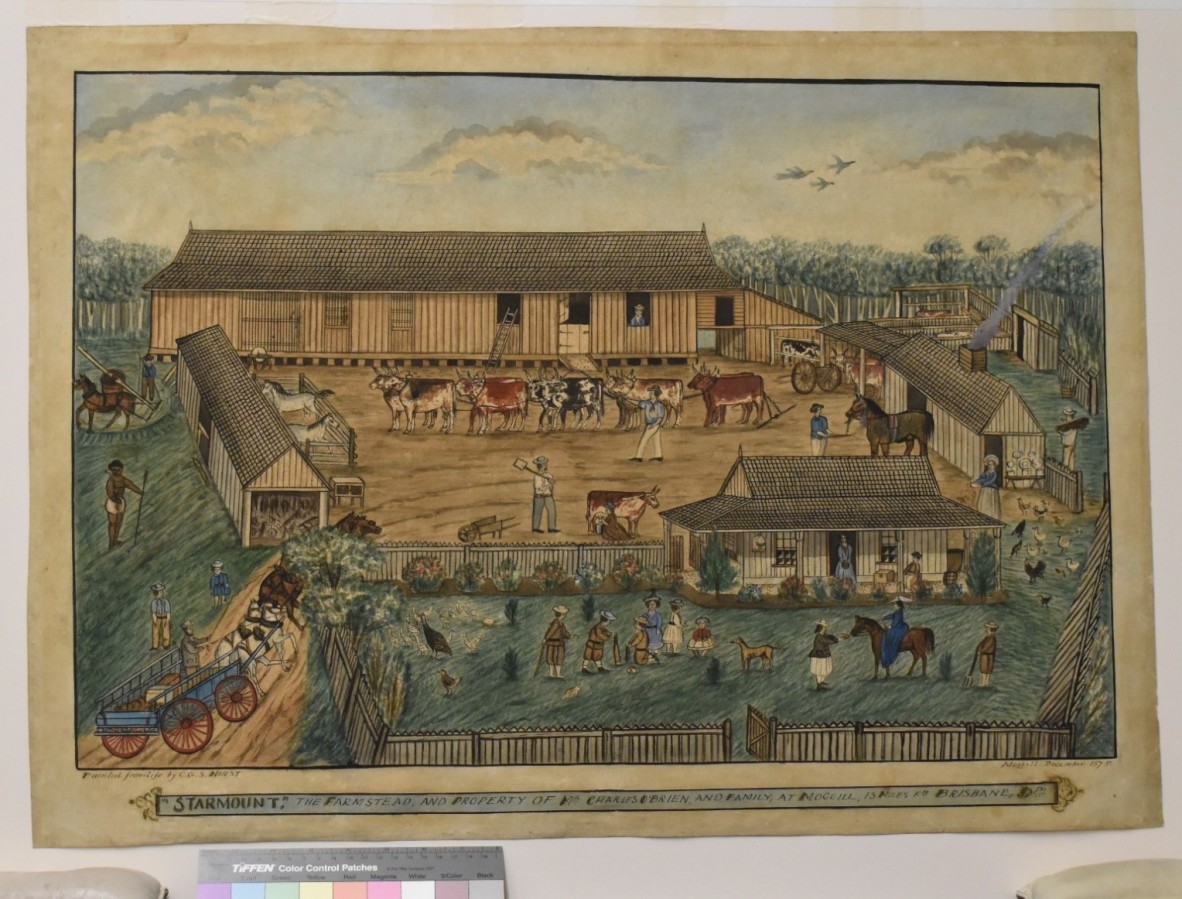
Starmount after conservation treatment. Note: surface dirt, disfiguring stains and acidic deterioration by-products have been minimised by washing the paper substrate and toning back strongly contrasting areas in the border. The artwork is now physically and chemically stable and ready for exhibition.
Be sure to plan a visit to the State Library of Queensland and see the artwork on display in the Treasures Wall on level 4.
Amelia O’Donnell - Conservation Technician, State Library of Queensland
Further reading -
Comments
Your email address will not be published.
We welcome relevant, respectful comments.